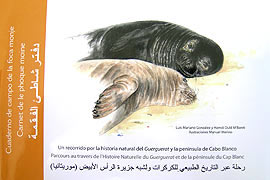Italy
“Incredible news” from Favignana… but the incredible fails to move officialdom
In early December 2004, Italy’s Gruppo Foca Monaca (GFM) reported the “incredible news” of a possible monk seal birth on Favignana, a small island off the west coast of Sicily.
It was the first confirmed incidence of a monk seal birth in the area in 20 years (the last one was a pup found dead in Sardinia in 1984), and suggested that reports of the species’ extinction in Italy might just be premature.
Mother and pup were found inside a sea cave by a local fisherman. “He came face to face with the female in the cave and both were very scared,” explains Emanuele Coppola of GFM, after he met and talked with the fisherman who reported the “close encounter” in Favignana. “The female escaped, and afterwards he noticed the pup that was also swimming in the 2-meter deep pool inside the cave. Then the pup also escaped.”
From the description of the animal’s physical appearance and in-cave behaviour provided by the fisherman, Coppola estimated the pup to be of about weaning age.
Reacting to the reports, GFM quickly put its contingency plan into effect, contacting local officials and fishermen both in person and by phone. Coppola himself went to Favignana, met the fisherman, had a long meeting with the Director of the local Marine Protected Area (the AMP Isole Egadi) to explain the great significance of the event, and was assured that all necessary measures to protect the mother and pup would be put into place. A sense of security, effectively eliminating disturbance by fishermen, tourists and journalists, would probably provide the only hope that the mother seal – and perhaps others – would return there in future years. Problems of potential disturbance and fisheries interactions were, in fact, the main concerns raised, based on recent experiences in Turkey, where pups have died even in protected areas, because young monk seals can be particularly vulnerable to entanglement in fishing gear.
After Coppola’s visit to the island, a written evaluation of the situation was submitted to the MPA Director as requested, reports Coppola, but unfortunately no reply was ever received.
“As stressed during the meeting with the Director,” says Coppola, “I reported in my evaluation the suggestion that the main danger for the pup might be caused by the activity of a few fishermen in the area, but no action was taken, not even to let them understand the need to avoid putting their nets in front of the most sensitive caves. I am quite sure that if the pup were then to have been found dead, entangled in a net, nobody would have reported it and any suspicions would have immediately been classified as pure fantasy.”
Coppola returned to Favignana in March this year, finding two caves in the area where the seals had been observed, including one whose characteristics could make it a good potential breeding cave.
However, there was no sign of mother or pup.
“I really hope that the animals are now safe and far from the area,” says Coppola. “The weather there has been very bad for most of the winter and human activity was therefore very limited.”
A mother and pup reappearance at Favignana or elsewhere in Italy’s southern coastal region would provide comforting reassurance that the species in Italy is back from the dead. For the species to stay alive, however, it is likely to require far greater efforts on the part of local officials.
Cilician monk seals find an audience in Rome, Trento and Prague
For the second time since 2003, the Gruppo Foca Monaca (GFM), in co-operation with the Turkish Embassy in Rome – notably the “Association for Friendship between Turkey and Italy” – invited Ali Cemal Gucu, professor of Marine Sciences in the Middle East Technical University (Mersin), to bring his Cilician Basin monk seal project to life in public lectures.
The first venue was in Rome, at the premises of the Natural History Museum, with the presence of the diplomatic authorities of the two countries but also the president of WWF Italy, Fulco Pratesi, journalists and many friends of the seals. The second occasion was near the Dolomites, in Trento, where an active group supporting monk seal protection wanted to have a “live” presentation of Prof. Gucu’s experience. On both the occasions the listeners were introduced, through the use of films and slides, plus a live “sunset” in Cilicia care of Panda Film, to the community of seals of the Cilician region – their past problems, their present situation, the trends of the population, the hopes and the fears, the newest monitoring techniques, and the extension of the project towards the Syrian borders.
Prof. Gucu and GFM also presented the results of their joint project on ecotourism (see Cilician Basin ecotourism project enters second phase, TMG 7 (2): November 2004), which has proven to be an important tool in creating further awareness among the inhabitants of the coastal villages involved in the conservation activities. A new trip for (as always) a very small group of people to Cilicia was advertised for the period between 22 and 31 October 2005 (for further info, please contact l.guarrera@aiab.it or visit the web site www.focamonaca.it )
Prof. Gucu’s last stop in Europe was Prague, where he was invited by the local University in the framework of a project on seal conservation and its relation to humans. The project foresees the participation of students (two accompanied Ali from Italy) and the preparation of a film, now underway. More news on this hopefully in the next issue of TMG. – Luigi Guarrera, Gruppo Foca Monaca.
NetWatch
Odyssey Sirens were Monk Seals
A German scientist claims to have found the Sirens of the Greek myth of Odysseus, who lured ships onto the rocks with their song: they are, in fact, monk seals.
Karl-Heinz Frommolt, head of the Archive of Animal Sounds at the Humboldt Museum in Germany, believes he has identified the Sirens' lair on the Li Galli islands, off Sorrento on Italy's Amalfi coast. The island is known as Le Sirenuse, the Island of the Sirens.
His team identified a configuration of rocks which amplifies sound coming from the island. However, tests showed a human voice could not reach far enough out to sea - whereas a moaning monk seal's could…
Historians, however, are not amused - believing the value of the tale does not lie in a literal interpretation of what are mythical figures.
Source: Odyssey Sirens ‘were monk seals’, BBC News, 19 May, 2005.
|
Mauritania & Western Sahara
Cap Blanc, up close
A beautifully illustrated book on monk seals, Mauritania, and the legendary Coast of Seals has been published by the Ministry of Environment in Madrid.
Written by Luis Mariano González and Hamdi Ould M’Barek, with illustrations by Manuel Merino Sánchez, the book takes in numerous aspects of life around the Cap Blanc peninsula, from the desert nomads crossing the Saharan sands, to the whales and dolphins passing by offshore, from the subsistence fisherman in their colourfully-painted pirogues to the cave-dwelling seals of the ‘Costa de las Focas’ and the waterfowl and waders of the Banc d’Arguin.
The book project was coordinated by Fundación CBD-Habitat.
Luis Mariano González and Hamdi Ould M’Barek. 2004. Cuaderno de camp de la foca monje. Carnet de le phoque moine. Ministerio de Medio Ambiente, Dirección para la Biodiversidad, Madrid: 1-72 [Spanish, French, Arabic].
IFAW boat studies mystery coast
Following on from its pledge to “ramp up” its monk seal conservation activities [IFAW defends seal priorities, this issue] the International Fund for Animal Welfare dispatched its research vessel Song of the Whale in May to survey the disputed coasts of the Western Sahara. North of the Mauritanian border and the Côte des Phoques, habouring the world’s largest surviving colony of Mediterranean monk seals, the coast is something of a mystery, with little survey work having been conducted in recent times. Historical documents indicate that monk seals were abundant as far north as the Rio d’Oro in the 15th century and were heavily exploited for their fur and oil by Portuguese explorers.
IFAW mounted its expedition in association with Fundación CBD-Habitat and its onsite technicians, the Institute National de Recherche Halieutique (INRH) of Morocco, and the Dakhla based NGO, Nature Initiative.
As we went to press, no significant new information on the monk seals of the area had been revealed.
A blog written by the boat’s crew is, however, available at:
http://www.ifaw.org/ifaw/general/default.aspx?oid=132403
|





